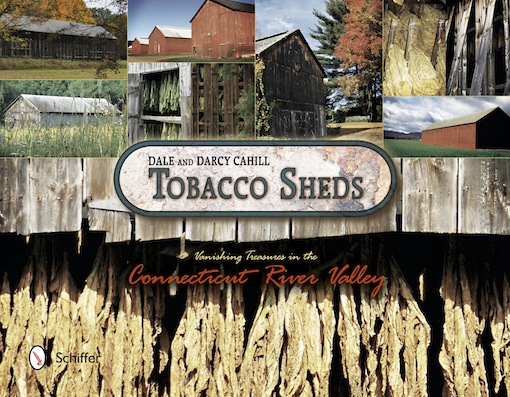Book Review: Tobacco Sheds — Vanishing Treasurers in the Connecticut River Valley
17 Jun 2014
To put it simply, this is a terrific book.
Whether you’re interested in history, cigars, preservation, tobacciana, or rural life, you’ll find yourself enchanted and enlightened as you move through this oversize volume just published by Schiffer Publishing for $24.99.

It will also likely sadden you a bit as you learn that these architectural treasures are rapidly vanishing from the landscape. Dale and Darcy Cahill, a pair of enthusiastic writers and photographers who have devoted themselves to documenting the sheds, estimate that more than 1,000 have been destroyed since their first volume on the subject was published in 2009.
This book uses a geographical theme to explore the sheds in words and roughly 250 photographs selected from about 7,000 frames. Beginning in Vermont and traveling the Connecticut River Valley south to Portland, Connecticut, the Cahills take readers on a marvelous journey.

In the book’s preface, cigar industry giant Carlito Fuente writes that “the tobacco barn stands tall, proud, and beautiful.†The Cahills describe it this way: “Whether standing inside or outside of a shed, a tobacco shed’s repetitive lines engage the eye†and the buildings themselves “evoke a sense of timelessness.â€
In addition to the structures, Tobacco Sheds provides fascinating introductions to people such as Mrs. Prout in South Windsor, Connecticut, who is said to be “the first person to roll a cigar in the United States,†and artist Erika H. Zekos, who lit a tobacco shed from inside as a public art project in 2009 to celebrate the 250th anniversary of Amherst, Massachusetts.
With the growing popularity of tourism to the cigar centers of Latin America, it seems an appropriate time to remember the reach and importance of cigar tobacco in the United States beyond Florida. And to do it not only with annual events, but by recognizing true artifacts.
This book is certainly a good way to do that. You should also check the Cahills’ website for other tobacco shed artwork, as well as their first book, Tobacco Sheds of the Connecticut River Valley. And StogieGuys.com will have more on the subject as well, with a interview of the Cahills and a contest you won’t want to miss.
photo credit: TobaccoSheds.com

 Patrick Ashby
Co-Founder & Editor in Chief
Patrick Ashby
Co-Founder & Editor in Chief Patrick Semmens
Co-Founder & Publisher
Patrick Semmens
Co-Founder & Publisher George Edmonson
Tampa Bureau Chief
George Edmonson
Tampa Bureau Chief
Interesting stuff. Sort of like The Bridges of Madison County for cigar smokers.
Somehow I don't think my wife will agree to a trip through CT to look at old tobacco sheds, though.
Even if you promise to divide the time between sight-seeing and stopping at outlet malls?
Pardon the newbie question, but does this book cover exactly what tobacco sheds are used for? I have no idea. I've heard of curing barns before… is this the same thing?
The tobacco barns are essential to storing, fermenting and aging tobacco. Here's Carlito Fuente from the books's preface: "The tobacco barn's role is not only one of protecting the elements from the tobacco it's nursing, but rather, transforming these elements or turning to its advantage in order for the bar to do its job. Like a fetus in a womb, demanding certain temperatures and humidities, and controlled air flow and darkness, amongst other things, are required for tobacco to develop optimally."